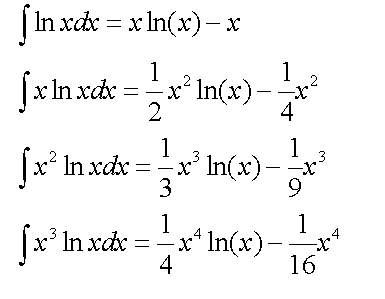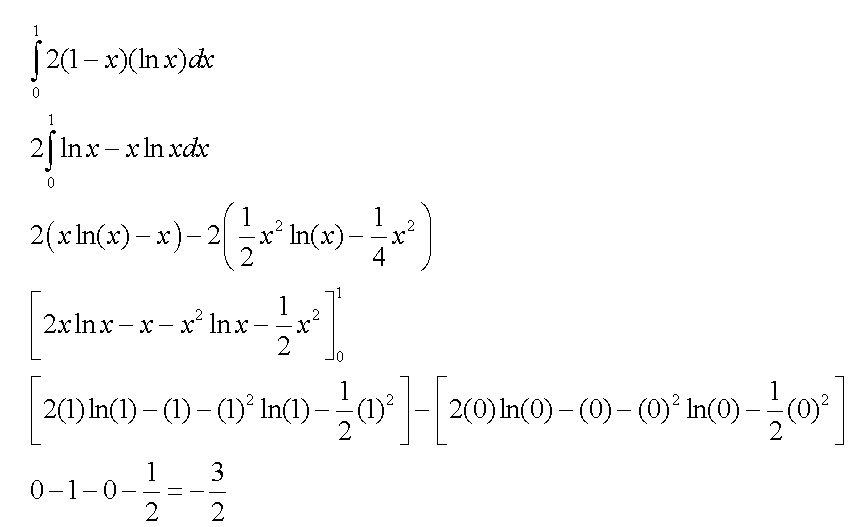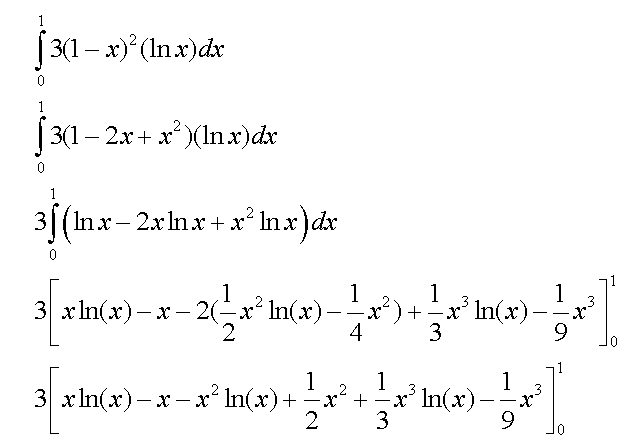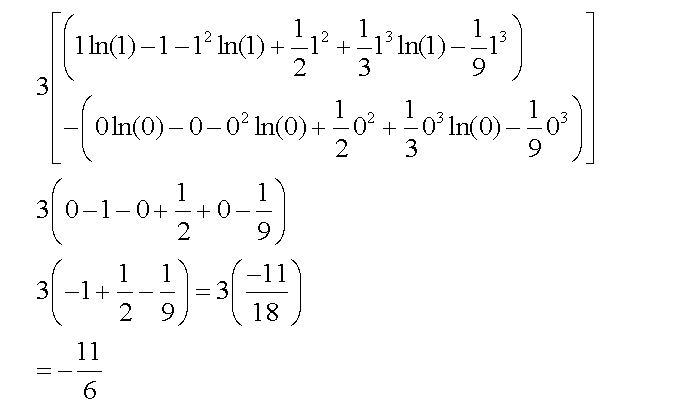Calculus: Early Transcendentals
8th Edition
ISBN:9781285741550
Author:James Stewart
Publisher:James Stewart
Chapter1: Functions And Models
Section: Chapter Questions
Problem 1RCC: (a) What is a function? What are its domain and range? (b) What is the graph of a function? (c) How...
Related questions
Question
Use patterns to Evaluate the following.
![**Observe the patterns in the following:**
\[
F_0(x) = \frac{1}{1} x (\ln x) - \frac{1}{1^2} x \quad \text{is an antiderivative of} \quad f_0(x) = \left( \ln x \right)
\]
\[
F_1(x) = \frac{1}{2} x^2 (\ln x) - \frac{1}{2^2} x^2 \quad \text{is an antiderivative of} \quad f_1(x) = x \left( \ln x \right)
\]
\[
F_2(x) = \frac{1}{3} x^3 (\ln x) - \frac{1}{3^2} x^3 \quad \text{is an antiderivative of} \quad f_2(x) = x^2 \left( \ln x \right)
\]
\[
F_3(x) = \frac{1}{4} x^4 (\ln x) - \frac{1}{4^2} x^4 \quad \text{is an antiderivative of} \quad f_3(x) = x^3 \left( \ln x \right)
\]
...
In each case above, \( F_n(x) \) represents an antiderivative of \( f_n(x) \), where \( f_n(x) \) is of the form \( x^n (\ln x) \). Notice the pattern in the coefficients and the powers of \( x \). The general form \( F_n(x) \) appears to be constructed by an initial fraction term involving \( x^{n+1} (\ln x) \) minus a fraction term involving \( x^{n+1} \).](/v2/_next/image?url=https%3A%2F%2Fcontent.bartleby.com%2Fqna-images%2Fquestion%2F239df334-5b03-4bc0-9001-d398335a6cd3%2F0972b8bc-2d9d-448d-b34b-64f8a6984720%2F97fs35q.jpeg&w=3840&q=75)
Transcribed Image Text:**Observe the patterns in the following:**
\[
F_0(x) = \frac{1}{1} x (\ln x) - \frac{1}{1^2} x \quad \text{is an antiderivative of} \quad f_0(x) = \left( \ln x \right)
\]
\[
F_1(x) = \frac{1}{2} x^2 (\ln x) - \frac{1}{2^2} x^2 \quad \text{is an antiderivative of} \quad f_1(x) = x \left( \ln x \right)
\]
\[
F_2(x) = \frac{1}{3} x^3 (\ln x) - \frac{1}{3^2} x^3 \quad \text{is an antiderivative of} \quad f_2(x) = x^2 \left( \ln x \right)
\]
\[
F_3(x) = \frac{1}{4} x^4 (\ln x) - \frac{1}{4^2} x^4 \quad \text{is an antiderivative of} \quad f_3(x) = x^3 \left( \ln x \right)
\]
...
In each case above, \( F_n(x) \) represents an antiderivative of \( f_n(x) \), where \( f_n(x) \) is of the form \( x^n (\ln x) \). Notice the pattern in the coefficients and the powers of \( x \). The general form \( F_n(x) \) appears to be constructed by an initial fraction term involving \( x^{n+1} (\ln x) \) minus a fraction term involving \( x^{n+1} \).
![### Integrals involving \((1 - x)^n (\ln x)\)
Below are several integral expressions, which involve integrating a product of a polynomial term \((1 - x)^n\) and a logarithmic term \(\ln x\), over the interval from \(x = 0\) to \(x = 1\):
1(a)
\[ \int_{x=0}^{1} 2 (1 - x) (\ln x) \, dx = \_\_\_\_\_. \]
1(b)
\[ \int_{x=0}^{1} 3 (1 - x)^2 (\ln x) \, dx = \_\_\_\_\_. \]
1(c)
\[ \int_{x=0}^{1} 4 (1 - x)^3 (\ln x) \, dx = \_\_\_\_\_. \]
1(d)
\[ \int_{x=0}^{1} 5 (1 - x)^4 (\ln x) \, dx = \_\_\_\_\_. \]
1(e)
\[ \int_{x=0}^{1} 6 (1 - x)^5 (\ln x) \, dx = \_\_\_\_\_. \]
\[ 6 \]
These integrals express how one can evaluate integrals of functions that are products of a polynomial and a logarithmic function over a specific interval. Each integral follows the general structure:
\[ \int_{x=0}^{1} n (1 - x)^{(n-1)} (\ln x) \, dx \]
where the coefficient \(n\) and the exponent \((n-1)\) change according to the specific integral being evaluated.](/v2/_next/image?url=https%3A%2F%2Fcontent.bartleby.com%2Fqna-images%2Fquestion%2F239df334-5b03-4bc0-9001-d398335a6cd3%2F0972b8bc-2d9d-448d-b34b-64f8a6984720%2F5yntlf3_reoriented.jpeg&w=3840&q=75)
Transcribed Image Text:### Integrals involving \((1 - x)^n (\ln x)\)
Below are several integral expressions, which involve integrating a product of a polynomial term \((1 - x)^n\) and a logarithmic term \(\ln x\), over the interval from \(x = 0\) to \(x = 1\):
1(a)
\[ \int_{x=0}^{1} 2 (1 - x) (\ln x) \, dx = \_\_\_\_\_. \]
1(b)
\[ \int_{x=0}^{1} 3 (1 - x)^2 (\ln x) \, dx = \_\_\_\_\_. \]
1(c)
\[ \int_{x=0}^{1} 4 (1 - x)^3 (\ln x) \, dx = \_\_\_\_\_. \]
1(d)
\[ \int_{x=0}^{1} 5 (1 - x)^4 (\ln x) \, dx = \_\_\_\_\_. \]
1(e)
\[ \int_{x=0}^{1} 6 (1 - x)^5 (\ln x) \, dx = \_\_\_\_\_. \]
\[ 6 \]
These integrals express how one can evaluate integrals of functions that are products of a polynomial and a logarithmic function over a specific interval. Each integral follows the general structure:
\[ \int_{x=0}^{1} n (1 - x)^{(n-1)} (\ln x) \, dx \]
where the coefficient \(n\) and the exponent \((n-1)\) change according to the specific integral being evaluated.
Expert Solution
Step 1
Given integral patterns

Step 2
Use the pattern to integrate each

Step 3
Now use the same integral pattern for the next problem


Trending now
This is a popular solution!
Step by step
Solved in 5 steps with 7 images

Knowledge Booster
Learn more about
Need a deep-dive on the concept behind this application? Look no further. Learn more about this topic, calculus and related others by exploring similar questions and additional content below.Recommended textbooks for you

Calculus: Early Transcendentals
Calculus
ISBN:
9781285741550
Author:
James Stewart
Publisher:
Cengage Learning

Thomas' Calculus (14th Edition)
Calculus
ISBN:
9780134438986
Author:
Joel R. Hass, Christopher E. Heil, Maurice D. Weir
Publisher:
PEARSON

Calculus: Early Transcendentals (3rd Edition)
Calculus
ISBN:
9780134763644
Author:
William L. Briggs, Lyle Cochran, Bernard Gillett, Eric Schulz
Publisher:
PEARSON

Calculus: Early Transcendentals
Calculus
ISBN:
9781285741550
Author:
James Stewart
Publisher:
Cengage Learning

Thomas' Calculus (14th Edition)
Calculus
ISBN:
9780134438986
Author:
Joel R. Hass, Christopher E. Heil, Maurice D. Weir
Publisher:
PEARSON

Calculus: Early Transcendentals (3rd Edition)
Calculus
ISBN:
9780134763644
Author:
William L. Briggs, Lyle Cochran, Bernard Gillett, Eric Schulz
Publisher:
PEARSON

Calculus: Early Transcendentals
Calculus
ISBN:
9781319050740
Author:
Jon Rogawski, Colin Adams, Robert Franzosa
Publisher:
W. H. Freeman


Calculus: Early Transcendental Functions
Calculus
ISBN:
9781337552516
Author:
Ron Larson, Bruce H. Edwards
Publisher:
Cengage Learning